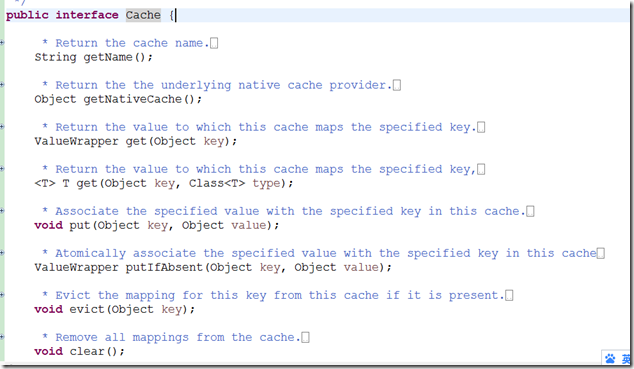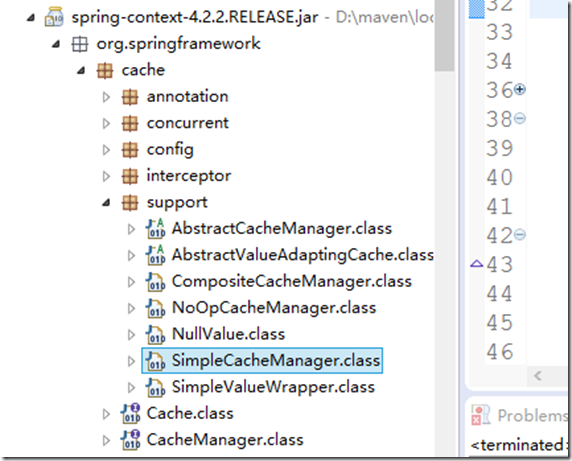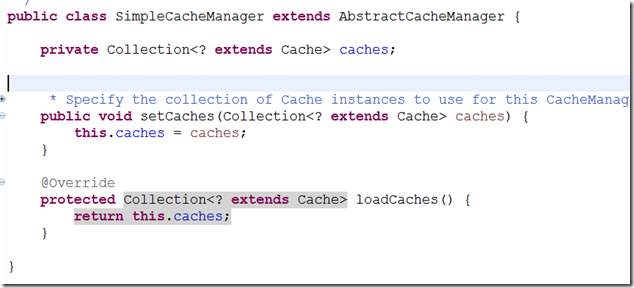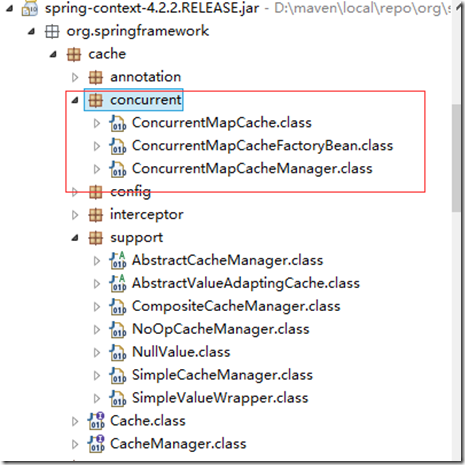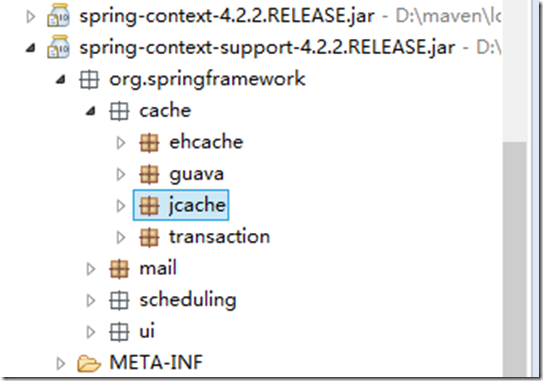1.spring从3.1开始支持缓存功能。spring 自带的缓存机制它只在方法上起作用,对于你使用其他持久化层的框架来讲,是没有影响的,相对来讲这种缓存方式还是不错的选择。
2.提供缓存的接口:org.springframework.cache.Cache ;org.springframework.cache.CacheManager这两个接口都在context中,一个是用来提供缓存的,一个是用来提供管理缓存的。
3.缓存是使用键值对的形式存在的,对应Java中就要使用Map<K,V>这种数据结构来处理,推荐使用java.util.concurrent.ConcurrentMap来存放。
4.注解:
在上面的注解中我们常用到的有@Cacheable,@CacheEvict,@CachePut这3个,我们目前也只学这3个
5.
@Cacheable:用来定义缓存的。常用到是value,key;分别用来指明缓存的名称和方法中参数,对于value你也可以使用cacheName,在查看源代码是我们可以看到:两者是指的同一个东西。
@CacheEvict:用来清理缓存。常用有cacheNames,allEntries(默认值false);分别代表了要清除的缓存名称和是否全部清除(true代表全部清除)。
@CachePut:用来更新缓存,用它来注解的方法都会被执行,执行完后结果被添加到缓存中。该方法不能和@Cacheable同时在同一个方法上使用。
6.对于@Caching注解来讲,如果有两种不同的需求,都是放在同一个方法上,这种需求如果只是使用@CacheEvict或者@CachePut是无法实现,因为他们不能多样化的作用在同一个方法上。可以使用@Caching(evict={@CacheEvict(“a1”),@CacheEvict(“a2”,allEntries=true)});@Caching源代码如下:
7.下面我们来看看CacheManager这个接口,源代码如下:
不难看出,最终目的还是用来获取Cache这个对象的,而我们缓存的数据都放在Cache中,部分源代码如下:
8.上面的一些基本的东西都已说完,下面看看怎么配置,让缓存真正的起作用:
来看看官方文档给的写法,里面重要的是spring-cache.xsd
其中的注解添加完,你就可以中代码中使用了:
在使用spring中缓存时,我们一般选择SimpleCacheManager这个类。
SimpleCacheManager源代码如下:
可以看出我们需要配置caches这个属性,来看看官方文档的例子吧,在xml中添加如下代码:创建了两个缓存的名称一个是books 一个是 default,我们可以只创建一个。
但是set中我们因该怎么写,在文章开头我们提到了ConcurrentMap这个类,再看下下面的红框中,我们选择一个,其中看其源代码可知道ConcurrentMapCacheFactoryBean内容包含其他两个。所有我们选择这个。
其源代码如下:
9.现在基本的配置都完成,现在就需要配置自己的bean去做下测试了。
编写一个逻辑处理的类,把该类放在xml定义:
public class TestCacheService { //通过参数name @Cacheable(cacheNames="uCache",key="#name") public User get(String name){ User u = new User(); u.setAge(12); u.setUserName("jobs"); System.out.println("没有缓存"+name); return u; } //通过方法名 @Cacheable(value="uCache",key="#root.methodName") public User get2(){ User u = new User(); u.setAge(12); u.setUserName("gate"); System.out.println("没有缓存"); return u; } }
编写一个测试类
public class TestCache { public static void main(String[] args) { ApplicationContext context = new ClassPathXmlApplicationContext("config/spring-cache.xml"); TestCacheService testCache = (TestCacheService)context.getBean("testCache"); testCache.get("jobs"); testCache.get("jobs");
}
}
运行测试一下,会发现报错,原因是xml中的p:name没有绑定:
在xml中添加:xmlns:p="http://www.springframework.org/schema/p"就可。
测试结果只有一行被打印处理,说明我们的缓存起作用了。
10.如何从缓存中提取缓存的数据:
首先我们要知道怎么从缓存中提取已经缓存过的数据:
public class TestCache { public static void main(String[] args) { ApplicationContext context = new ClassPathXmlApplicationContext("config/spring-cache.xml"); TestCacheService testCache = (TestCacheService)context.getBean("testCache"); CacheManager cm = (CacheManager) context.getBean("cacheManager"); //添加数据到缓存中 testCache.get("job"); Cache uCache = cm.getCache("uCache"); //通过参数作为key,得到对应的value User u1 = (User) uCache.get("job").get(); u1.show(); //添加数据到缓存中 testCache.get2(); //通过方法名作为key,得到对应value User u2 = (User) uCache.get("get2").get(); u2.show(); } }
当然还有其他形式作为其key,类如官方文档就给了如下参考,它是使用spel:
当让还有其它的缓存技术,例如ehcache,guava,jcache:
这个是我例子中用到的源代码:spring缓存技术Caching例子




